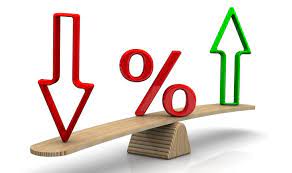Вплив відсоткової ставки на курс валюти
У сучасному глобальному фінансовому світі все взаємопов’язане. Найменші економіки залежать від більших, а капітал, як і раніше, йде у вигідні регіони. При цьому в нинішній фінансовій моделі для регулювання зростання економік або подолання криз використовуються ті самі інструменти, що застосовувалися сотні років тому. Одним із таких потужних національних та глобальних інструментів є відсоткові ставки ЦП.
Процентні ставки – це найважливіший і основний інструмент впливу будь-якого Центрального банку, як на економіку, так і на курс національної валюти. При цьому основне завдання ЦП полягає у підтримці національної валюти на певному рівні. Чому це так важливо?
 Від курсу валюти залежить насамперед інфляція, тобто знецінення валюти стосовно товарів за певний проміжок часу. Більшість ЦБ світу, перед тим як ухвалити рішення про підвищення чи зниження відсоткової ставки звертають увагу саме на інфляцію, другим суттєвим параметром є безробіття. Параметри інфляції та безробіття дуже важливі для економіки. Вони безпосередньо впливають на громадян і породжують чи знижують соціальну напруженість. Наприклад, високий рівень інфляції (гіперінфляція) призводить до знецінення накопичень громадян і водночас подорожчання товарів і послуг, завдаючи подвійного удару. Високе безробіття – це характерний показник кризи економіки. Через високе безробіття не тільки складно влаштовуватись на роботу, а й неможливо розраховувати на хорошу заробітну плату, крім того, зростає кількість злочинів.
Від курсу валюти залежить насамперед інфляція, тобто знецінення валюти стосовно товарів за певний проміжок часу. Більшість ЦБ світу, перед тим як ухвалити рішення про підвищення чи зниження відсоткової ставки звертають увагу саме на інфляцію, другим суттєвим параметром є безробіття. Параметри інфляції та безробіття дуже важливі для економіки. Вони безпосередньо впливають на громадян і породжують чи знижують соціальну напруженість. Наприклад, високий рівень інфляції (гіперінфляція) призводить до знецінення накопичень громадян і водночас подорожчання товарів і послуг, завдаючи подвійного удару. Високе безробіття – це характерний показник кризи економіки. Через високе безробіття не тільки складно влаштовуватись на роботу, а й неможливо розраховувати на хорошу заробітну плату, крім того, зростає кількість злочинів.
Зміна ставок прямо впливає на всю економіку (нехай це відбувається і не одномоментно). У кожній країні існує кілька видів процентних ставок. Основною відсотковою ставкою є облікова ставка (рефінансування). Насправді це дисконтна ставка, під яку ЦБ видає кредити комерційним банкам.
Чому дисконтна? Є два основні методи нарахування відсотків за ставкою. Процентна ставка (interest rate) – в цьому разі відсотки за кредитом виплачуються в міру повернення позики. Дисконтна ставка (discount rate) – у такому разі сума кредиту, що видається, зменшена на відсоток за кредитом.
Окрім облікової ставки є ще депозитні та міжбанківські ставки, але найбільший вплив на валютний курс має саме облікова. Розберемося, як впливає відсоткова ставка на курс валюти.
Як впливає на курс валюти збільшення ставки
До збільшення ставки можуть призвести дві події:
Перша подія – різке падіння вартості національної валюти на тлі економічної кризи. Наприклад, у 2015 році в Росії на тлі зниження цін на нафту, конфлікт з Україною та вступу перших західних санкцій почалася валютна криза.
Друга подія – можливий “перегрів” економіки та зростання інфляції. У цьому випадку ЦБ уважно дивиться на інфляційний таргет і безробіття.
Вплив відсоткової ставки на курс валюти наступний, вище ставка – привабливіша валюта (особливо у нерезидентів). Підвищення ставки веде до зміцнення національної валюти у середньостроковій та довгостроковій перспективі. При цьому підвищення ставки негативно впливає на кредитування бізнесу, веде до зростання безробіття та виведення коштів з обігу, негативно впливаючи на всю економіку.
Як впливає на курс валюти зниження ставки
Прочитавши, як впливає підвищення відсоткової ставки логічним було б припустити, що її зниження має зворотний ефект. Низькі ставки роблять національну валюту менш затребуваною у нерезидентів. Прибутки за борговими інструментами в такому разі низькі, попит на національну валюту слабкий, курс падає. Проте, низькі ставки – це вигідніші кредити населення і компаній, у результаті зростає виробництво і кількість робочих місць і скорочується безробіття.
Висновок
Вплив відсоткової ставки на валютний курс має прямий характер, відсоткові ставки зростають — валюта зміцнюється, а якщо знижуються — то слабшає. При цьому зниження ставок стимулює зростання та розвиток економіки, а підвищення знижує економічне зростання.
Експерт в області інтернет-маркетингу. Керівник маркетингового агентства MAVR.
Бізнес-ступінь “Майстер ділового адміністрування” (MBA).

